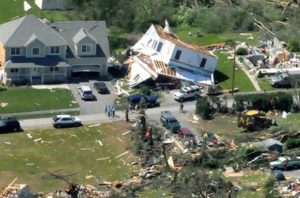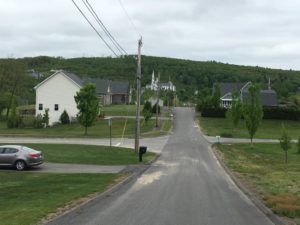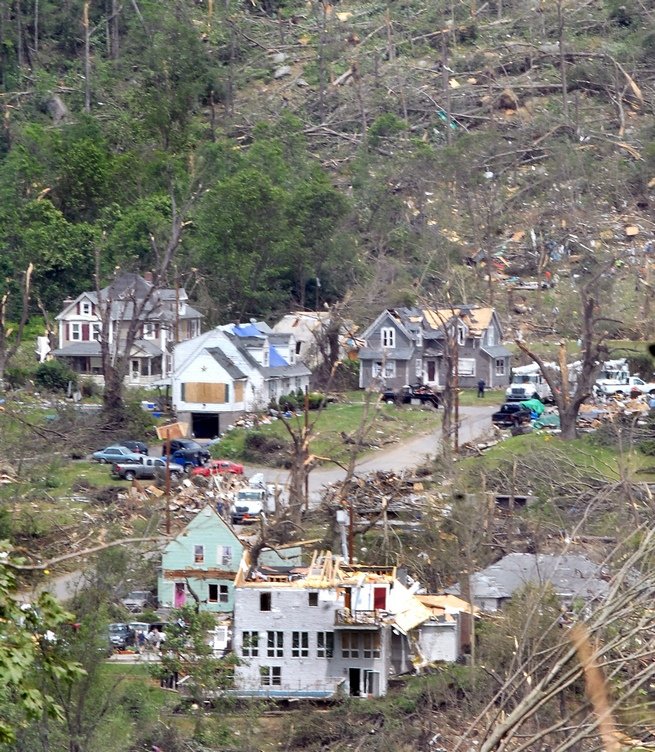Five years ago, on June 1, 2011, an F3 tornado, with wind speeds between 150 and 200 miles per hour, swept through eight communities across western and central Massachusetts, from Westfield east to Southbridge.
RELATED: Five Years After Tornado’s Thrashing, A Springfield Community Strives For Progress, Unity
FROM THE ARCHIVES: Storm Stories: Path of Fury
One of the hardest hit was Monson, where the tornado cut nearly a half-mile swath of devastation through the center of town of about 8,500 residents.
Among the buildings in the tornado’s path that Wednesday afternoon was the First Church of Monson, whose steeple was toppled and destroyed. Miraculously enough, its stained glassed windows all survived. The parsonage across the street where the Reverend Bob Marrone and his family lived, did sustain heavy damage. Marrone says he saw TV footage of the tornado as it crossed the Connecticut River into Springfield. But he says he didn’t give it much thought — that is, until he heard hail coming down and saw trees blowing in one direction.

“It was a steady blow,” Marrone says. “It wasn’t like normally when you see winds in a storm that the trees will move in different directions. This was all going one direction. And that’s when my ears popped and that’s when I knew that we were in trouble.”
Marrone, who’s often referred to as Pastor Bob, says he and his wife ran down under the basement stairs and listened as the tornado blew over the house.
“People talk about the freight train,” Marrone says. “My wife heard that. All I heard was the air being sucked out of the cracks in the house. It just was this thin, whiny sound and that’s one of the things that stays with me.”
‘I hope we live,'” he recalls thinking. “I was not sure that we were going to survive.”
Another church steeple in town was toppled, and several other landmarks damaged or destroyed, including an historic gymnasium that was once a part of Monson Academy, and the town office building, which was built in 1925 as Monson’s first high school.
“The entire structure was twisted,” says Town Administrator Evan Brassard. “The roof was gone, tremendous amount of water damage, the hallways were curved. It was really substantial damage.”
More than 230 buildings in Monson were damaged; about a third were total losses.
One of those belonged to the family of Laura Yarbrough, who huddled with her terrified 12 year-old son Joey in the basement of her home until the tornado passed. She calls it the longest 45 seconds of her life.

“I saw an opening in the corner of the basement where the house had pulled away from the foundation. And there was a tool chest there so I pulled the drawers open and used them as stairs to get up to ground level, and climbed up. So it was like coming up into this completely changed landscape. It was like a movie scene,” Yarbrough says. “I remember the look on my neighbor’s face across the street. Like, she just saw us rise from the dead. I mean, the house [was] completely leveled.”
Laura and her son were left shaken, but unhurt. Luckily no one in Monson lost their life, but one woman in neighboring Brimfield died when the camper she was in went airborne in a trailer park.
Five years on, much rebuilding has taken place. There’s a new $10 million town office building and many new homes in the tornado zone. The church steeples that were toppled and destroyed have been replaced.
The trees that survived the uprooting from the tornado are beginning to green. And Brassard says newly planted trees will take many more years to fully blossom.
You don’t realize it until they’re gone. Not much that changes the aesthetic and, you know, the feel of Monson,” he says. “We’re a rural Massachusetts community. We’re small and we have a lot of forest. And when you lose that, it has an impact.”
As we take a drive to what used to be Laura Yarbrough’s home on Stewart Avenue, that totally changed landscape she referred to earlier — what had been a wooded neighborhood with tree-lined streets — remains strikingly exposed. It’s not far from her current home, but she’s only visited her old neighborhood a couple of times since the tornado.

“All these houses are new. That house was never redone. There was a house standing there,” she said on a recent visit back, motioning to an empty lot with only a mailbox. “So this is new. This house was literally like in the road and rubble — just gone. And this is where we [our house was], right here…So it’s quite a view now [with the trees gone]. In the winter I could see the steeple from First Church, but not at this time of year.”
Yarbrough and her family decided to sell the land to a neighbor and move. But life after the tornado has been far from settled. She moved more than a half dozen times in five communities before finding herself once again in Monson. She also separated from her husband for a while, but they have since reconciled. And her eldest son, who left the house before the tornado hit, is currently in a drug treatment facility.
She says the whole experience, from trying to recover what family belongings she could to dealing with insurance companies, unscrupulous individuals and what she calls unhelpful agencies — she is not a fan of the Red Cross — left her exhausted.
I don’t know how people did it,” Yarbrough says. “I’m trying to think like older people, because it was so much work and so tedious.”
So how did she cope?
“I don’t know,” she says. “I don’t know. It’s a good question.”
Ironically, Yarbrough says her experience has been invaluable in her new job, that of an insurance adjustor.
For Pastor Bob Marrone, he moved to Peterborough, New Hampshire, last year. He says he’s only recently begun to feel much better after undergoing counseling, although he still feels stress when he hears heavy wind storms. He says the church rebuilding project took much longer than first projected , which prolonged the trauma of the tornado. He says he also observed relationships fall apart and people taking to drink as a result of the stress.
To be sure, Marrone says, the recovery is not yet complete, for him or for the residents of Monson.
“This is a trauma that does not go away quickly. Having at least a chance to be away from the location has been very therapeutic for me, but the people who are still there — the scar and the landscape is a constant reminder of this trauma. And it will be the story that that community tells for many years,” Marrone says. “When I arrived there were stories of the 1955 flood, which was devastating to the town, and people were still talking about that in 2004. It was like it was still fresh in people’s memories. This tornado will be in people’s memories for generations.”
Both Marrone and town administrator Evan Brassard say one good thing to emerge from the stress and grief of June 1st, 2011, is the spirit that seems to have prompted more residents to work together in how they want to town to look and operate.
And volunteerism that kind of expanded beyond the tornado,” Brassard says. “So when the need for help after the tornado was gone, they moved on to supporting the troops or to give back to other communities the way that they were assisted.”
The hope, Brassard says, is that spirit of volunteerism will continue long after the physical and emotional scars of the tornado begin to fade.
Meanwhile, to observe the anniversary of the tornado, a Walk of Reflection is being held in Monson Wednesday starting at 5 p.m. at the First Church parking lot. And on Sunday, the church will hold a service of remembrance and thanksgiving.
